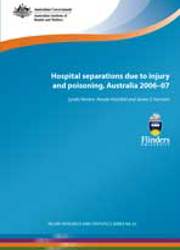Summary
This report, covering injuries resulting in admission to Australian hospitals in the financial year 2006-07, is the fifth in the series which started in 2001-02 (Berry & Harrison 2006a).
The focus of the report is analysis of community injury (that is, injuries typically sustained in the home, workplace, street, etc.). The report also includes short sections on work and sports related injury, complications of surgical and medical care and residual injury such as adverse effects not elsewhere classified.
An estimated 386,208 community injury cases required hospitalisation during the twelve-month period 2006-07 (225,297 males and 160,905 females).
A total of 1,553,030 patient days were attributed to hospitalised community injury, equating to a mean length of stay of 4 days per hospitalised case.
The leading causes of hospitalised injury were unintentional falls, which accounted for
36% of all community injury cases. Unlike for most other types of community injury, females outnumbered males (56% to 44%) and rates were highest for older Australians.
The second most common causes of hospitalised injury were transport accidents (14% or 53,829 cases). Males had higher rates of transport injury hospitalisations than females across all age groups, with the highest rates among those aged 10-29.
For very young children aged 0-4, the most common specific causes of injury were falls (40%), fires, burns and scalds and poisoning by drugs (both 7%). Falls were also the most common cause of injury for older children aged 5-14 (43%), followed by transport accidents (19%). The most common causes of injury for young adults aged 15-24 were transport accidents (21%), falls (13%), assault (11%) and intentional self-harm (10%). A similar pattern was seen in adults aged 25-44 where transport accidents accounted for 18% of hospitalisations, falls for 14% and assault and intentional self-harm for 11% each. For adults aged 45-64, falls were prominent, accounting for 32% of hospitalisations, followed by transport accidents (14%) and intentional self-harm (7%). For those aged 65 and over, well over three-quarters of hospitalisations were the result of falls (77%).
Just over a quarter of all hospitalised injury cases occurred at home. A higher percentage of females than males were injured at home (36% vs. 19%) or in a residential institution
(8% vs. 2%). Males were more likely than females to have been injured on a street or highway, as well as in sports and athletics areas, trade and construction areas, and farms.
Rates of community injury increased with geographical remoteness. The lowest rate of 1,665 per 100,000 was found for Major cities while the highest rate was found for Very remote regions (3,947 per 100,000 population).



